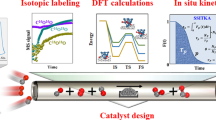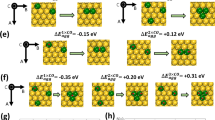Abstract
Identification of metal cluster catalysis is a topic that is being investigated since a long time. Here, we report a Pd3 metal cluster catalytic reaction investigated by means of operando studies. We discovered that atomically defined tri-nuclear palladium (Pd3) is a surprisingly active catalyst for the cycloisomerization of 2-phenylethynylaniline. Operando 1H NMR spectroscopy and X-ray extended absorption fine structure (EXAFS) measurements have indicated that the structural integrity of such a catalyst remains intact throughout the reaction, which has also been confirmed by an ex situ X-ray photoelectron spectroscopy (XPS) study and catalyst recycling experiments. Kinetic data derived from operando IR spectroscopy measurements have shown that Pd3 is the active catalytic species. Density functional theory calculations have revealed a reaction pathway consistent with the kinetic data, further supported by NMR titration and X-ray crystal structure studies. Overall, the present study presents a clear example of metal cluster catalysis.

Similar content being viewed by others
References
Yermakov, Y. I.; Kuznetsov, B. N.; Zakharov, V. A. Catalysis by supported complexes. In Studies in Surface Science and Catalysis; Elsevier: New York, 1981; Vol. 8, pp 1–522.
Basset, J.-M.; Gates, B. C.; Candy, J. P.; Choplin, A.; Leconte, M.; Quignard, F.; Santini, C. Surface Organometallic Chemistry: Molecular Approaches to Surface Catalysis; Springer: Dordrecht, the Netherlands, 1988.
Astruc, D. Transition-metal nanoparticles in catalysis: From historical background to the state-of-the art. In Nanoparticles and Catalysis; Astruc, D., Ed.; Wiley-VCH Verlag Gmbh & Co.: Weinheim, Germany, 2008; Vol. 1, pp. 1–48.
Tao, F.; Grass, M. E.; Zhang, Y. W.; Butcher, D. R.; Renzas, J. R.; Liu, Z.; Chung, J. Y.; Mun, B. S.; Salmeron, M.; Somorjai, G. A. Reaction-driven restructuring of Rh-Pd and Pt-Pd core–shell nanoparticles. Science 2008, 322, 932–934.
Jiang, B. J.; Song, S. Z.; Wang, J. Q.; Xie, Y.; Chu, W. Y.; Li, H. F.; Xu, H.; Tian, C. G.; Fu, H. G. Nitrogen-doped graphene supported Pd@PdO core–shell clusters for C–C coupling reactions. Nano Res. 2014, 7, 1280–1290.
Pang, F.; Liu, X. T.; He, M. Y.; Ge, J. P. Ag3PO4 colloidal nanocrystal clusters with controllable shape and superior photocatalytic activity. Nano Res. 2015, 8, 106–116.
Häkkinen, H. The gold–sulfur interface at the nanoscale. Nat. Chem. 2012, 4, 443–455.
Serna, P.; Gates, B. C. Molecular metal catalysts on supports: Organometallic chemistry meets surface science. Acc. Chem. Res. 2014, 47, 2612–2620.
Jones, C. W.; Tao, F.; Garland, M. V. Introduction to special issue on operando and in situ studies of catalysis. ACS Catal. 2012, 2, 2444–2445.
Bayram, E.; Linehan, J. C.; Fulton, J. L.; Roberts, J. A. S.; Szymczak, N. K.; Smurthwaite, T. D.; Ozkar, S.; Balasubramanian, M.; Finke, R. G. Is it homogeneous or heterogeneous catalysis derived from [RhCp*Cl2]2 In operando XAFS, kinetic, and crucial kinetic poisoning evidence for subnanometer Rh4 cluster-based benzene hydrogenation catalysis. J. Am. Chem. Soc. 2011, 133, 18889–18902.
Oliver-Meseguer, J.; Cabrero-Antonino, J. R.; Domínguez, I.; Leyva-Pérez, A.; Corma, A. Small gold clusters formed in solution give reaction turnover numbers of 107 at room temperature. Science 2012, 338, 1452–1455.
Murahashi, T.; Fujimoto, M.; Oka, M.; Hashimoto, Y.; Uemura, T.; Tatsumi, Y.; Nakao, Y.; Ikeda, A.; Sakaki, S.; Kurosawa, H. Discrete sandwich compounds of monolayer palladium sheets. Science 2006, 313, 1104–1107.
Murahashi, T.; Hashimoto, Y.; Chiyoda, K.; Fujimoto, M.; Uemura, T.; Inoue, R.; Ogoshi, S.; Kurosawa, H. Reductive coupling of metal triangles in sandwich complexes. J. Am. Chem. Soc. 2008, 130, 8586–8587.
Babbini, D. C.; Cluff, K. J.; Fisher, N. B.; Charbonneau, J. C.; Nichol, G. S.; Hurst, S. K. New trimetallic sandwich complexes of platinum(0) and palladium(0). J. Organometal. Chem. 2012, 713, 217–221.
Witham, C. A.; Huang, W. Y.; Tsung, C.-K.; Kuhn, J. N.; Somorjai, G. A.; Toste, F. D. Converting homogeneous to heterogeneous in electrophilic catalysis using monodisperse metal nanoparticles. Nat. Chem. 2010, 2, 36–41.
Blackmond, D. G. Reaction progress kinetic analysis: A powerful methodology for mechanistic studies of complex catalytic reactions. Angew. Chem., Int. Ed. 2005, 44, 4302–4320.
Mathew, J. S.; Klussmann, M.; Iwamura, H.; Valera, F.; Futran, A.; Emanuelsson, E. A. C.; Blackmond, D. G. Investigations of Pd-catalyzed ArX coupling reactions informed by reaction progress kinetic analysis. J. Org. Chem. 2006, 71, 4711–4722.
Leyva-Pérez, A.; Oliver-Meseguer, J.; Rubio-Marqués, P.; Corma, A. Water-stabilized three-and four-atom palladium clusters as highly active catalytic species in ligand-free C–C cross-coupling reactions. Angew. Chem., Int. Ed. 2013, 52, 11554–11559.
Yanai, T.; Tew, D. P.; Handy, N. C. A new hybrid exchange–correlation functional using the Coulomb-attenuating method (CAM-B3LYP). Chem. Phys. Lett. 2004, 393, 51–57.
Author information
Authors and Affiliations
Corresponding authors
Electronic supplementary material
Rights and permissions
About this article
Cite this article
Lv, C., Cheng, H., He, W. et al. Pd3 cluster catalysis: Compelling evidence from in operando spectroscopic, kinetic, and density functional theory studies. Nano Res. 9, 2544–2550 (2016). https://doi.org/10.1007/s12274-016-1140-8
Received:
Accepted:
Published:
Issue Date:
DOI: https://doi.org/10.1007/s12274-016-1140-8




